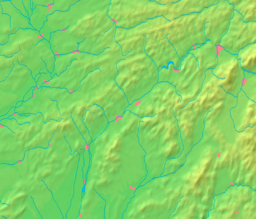Bojnice
| Bojnice | |
| Town | |
|
Town Bojnice and castle
|
|
| Country | Slovakia |
|---|---|
| Region | Trenčín |
| District | Prievidza |
| Elevation | 298 m (978 ft) |
| Coordinates | 48°46′45″N 18°35′00″E / 48.77917°N 18.58333°ECoordinates: 48°46′45″N 18°35′00″E / 48.77917°N 18.58333°E |
| Area | 19.96 km2 (7.71 sq mi) |
| Population | 4,983 (2005) |
| Density | 250/km2 (647/sq mi) |
| First mentioned | 1113 |
| Mayor | František Tám |
| Timezone | CET (UTC+1) |
| - summer (DST) | CEST (UTC+2) |
| Postal code | 972 01 |
| Area code | +421-46 |
| Car plate | PD |
| Statistics: MOŠ/MIS | |
| Website: www.bojnice.sk | |
Bojnice (Hungarian: Bajmóc, German: Weinitz) is a historical town in central Slovakia at the upper Nitra river, near the city of Prievidza. It has population of 4,983 (2005). Bojnice is best known for its tourist attractions: the oldest zoo in Slovakia, the most visited castle, and one of the oldest spa towns in Slovakia. The town is situated below the Bojnice Castle, which is built on travertine rock with a natural cave. The castle has appeared in many international films and a well-known international festival of spectres takes place there every year.
The town lies at the upper Nitra river valley, under the Strážov Mountains. It is very close to Prievidza (4 km), sharing the public transport system. Other major cities nearby include Žilina to the north (60 km) and Trenčín to the west (65 km).
The town's history is closely connected to that of Bojnice Castle. It was first mentioned in 1113, when it was mentioned as a settlement under the castle. It has town privileges since 1966.
The town is most known for its tourist attractions: the Bojnice Castle, first mentioned in 1113 and originally built as a wooden fort, it was over time built as a stone castle and in the 20th century in the Romantic style. Today, it is a popular tourist attraction.
The zoo (one of only four in Slovakia) was founded in 1955. In 2006 it had 355 different species and more than 1,800 animals.
It is also known for its spa. The therapeutic springs were mentioned in 1549 for the first time. Today they treat patients with disorders of the locomotor system, with rheumatic diseases, post traumatic conditions, conditions after orthopaedic disturbances of the spine of adolescents, neurological diseases and occupational diseases.
...
Wikipedia





